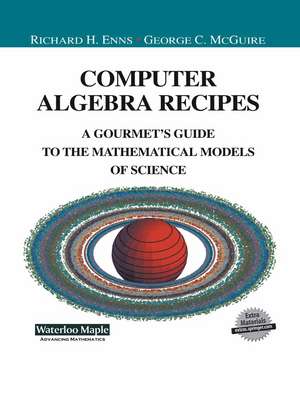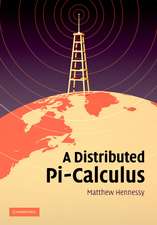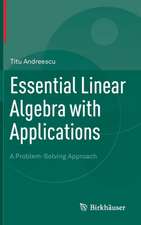Computer Algebra Recipes: A Gourmet’s Guide to the Mathematical Models of Science: Undergraduate Texts in Contemporary Physics
Autor Richard Enns, George C. McGuireen Limba Engleză Paperback – 2 mai 2013
Aimed at undergraduates in their second or third year, this book is filled with examples from a wide variety of disciplines, including biology, economics, medicine, engineering, game theory, physics, chemistry. The text is organized along a spiral, revisiting general topics such as graphics, symbolic computation, and numerical simulation in greater detail and more depth at each turn of the spiral.
The heart of the text is a large number of computer algebra recipes. These have been designed not only to provide tools for problem solving, but also to stimulate the reader's imagination. Associated with each recipe is a scientific model or method and a story that leads the reader through steps of the recipe. Each section of recipes is followed by a set of problems that readers can use to check their understanding or to develop the topic further.
| Toate formatele și edițiile | Preț | Express |
|---|---|---|
| Paperback (1) | 426.62 lei 39-44 zile | |
| Springer – 2 mai 2013 | 426.62 lei 39-44 zile | |
| Hardback (1) | 679.47 lei 6-8 săpt. | |
| Springer – 8 iun 2001 | 679.47 lei 6-8 săpt. |
Preț: 426.62 lei
Nou
Puncte Express: 640
Preț estimativ în valută:
81.65€ • 84.92$ • 68.43£
81.65€ • 84.92$ • 68.43£
Carte tipărită la comandă
Livrare economică 10-15 martie
Preluare comenzi: 021 569.72.76
Specificații
ISBN-13: 9781461265337
ISBN-10: 1461265339
Pagini: 796
Ilustrații: XIV, 778 p.
Dimensiuni: 178 x 235 x 42 mm
Ediția:Softcover reprint of the original 1st ed. 2001
Editura: Springer
Colecția Springer
Seria Undergraduate Texts in Contemporary Physics
Locul publicării:New York, NY, United States
ISBN-10: 1461265339
Pagini: 796
Ilustrații: XIV, 778 p.
Dimensiuni: 178 x 235 x 42 mm
Ediția:Softcover reprint of the original 1st ed. 2001
Editura: Springer
Colecția Springer
Seria Undergraduate Texts in Contemporary Physics
Locul publicării:New York, NY, United States
Public țintă
Lower undergraduateCuprins
From the contents: Introduction: 0.1. Computer Algebra Systems. 0.2. The Spiral Staircase to Learning. 0.3. How to Climb the Spiral Staircase.-I. THE APPETIZERS: 1. The Pictures of Science: 1.1. Introduction. 1.2. Data and Function Plots: 1.2.1. Correcting for Inflation; 1.2.2. The Plummeting Badminton Bird; 1.2.3. Minimizing the Travel Time. 1.3. Log-log (Power Law) Plots: 1.3.1. Chimpanzee Brain Size; 1.3.2. Scaling Arguments and Gulliver's Travels. 1.4. Contour and Gradient Plots: 1.4.1. The Secret Message; 1.4.2. Designing a Ski Hill. 1.5. Animated Plots: 1.5.1. Waves are Dynamic; 1.5.2. The Sands of Time.2. Deriving Model Equations: 2.1. Introduction. 2.2. Linear Correlation: 2.2.1. What is Linear Correlation? 2.2.2. The Corn Palace. 2.3. Lease Squares Derivation of Model Equations: 2.3.1. Regression Analysis; 2.3.2. Will You Be Better Off Than Your Parents? 2.3.3. What was the Heart Rate of a Brachiosaurus? 2.3.4. Senate Renewal; 2.3.5. Bikini Sales and the Logistic Curve; 2.3.6 Following the Dow Jones Index; 2.3.7. Variation of 'g' with Latitude; 2.3.8. Finding Romeo a Juliet. 2.4. Deriving Multiple Regression.
Recenzii
From the reviews:
"In the book, the authors are showing the reader what they can do with Maple 6, and they can do a lot. Simply flipping the pages of the book, the reader might get very inspired by the formulas and pictures. … Most of the text I covered up to now contains useful and exciting examples … . the book is definitely very useful for educators … ." (L. Kocbach, Computer Physics Communications, Vol. 144, 2002)
"This book captures the essence of the CAS approach and it is the best book of its kind that I am aware of. The level of mathematics, the eclectic, abundant and carefully selected problem set, the friendly and expansive text and the clear demonstration of the power of the CAS approach all add up to a first rate book. … I highly recommend that you get your library to order a copy." (B.I. Henry, The Physicist, Vol. 39 (2), 2002)
"This book is a readable introduction to Maple, a computer algebra system. The authors present real life situations, describe them in the language of mathematics, and then use Maple to find or deduce conclusions, predictions and classifications of each of these situations." (Václav Koubek, Zentralblatt MATH, Vol. 976, 2002)
"In the book, the authors are showing the reader what they can do with Maple 6, and they can do a lot. Simply flipping the pages of the book, the reader might get very inspired by the formulas and pictures. … Most of the text I covered up to now contains useful and exciting examples … . the book is definitely very useful for educators … ." (L. Kocbach, Computer Physics Communications, Vol. 144, 2002)
"This book captures the essence of the CAS approach and it is the best book of its kind that I am aware of. The level of mathematics, the eclectic, abundant and carefully selected problem set, the friendly and expansive text and the clear demonstration of the power of the CAS approach all add up to a first rate book. … I highly recommend that you get your library to order a copy." (B.I. Henry, The Physicist, Vol. 39 (2), 2002)
"This book is a readable introduction to Maple, a computer algebra system. The authors present real life situations, describe them in the language of mathematics, and then use Maple to find or deduce conclusions, predictions and classifications of each of these situations." (Václav Koubek, Zentralblatt MATH, Vol. 976, 2002)



















